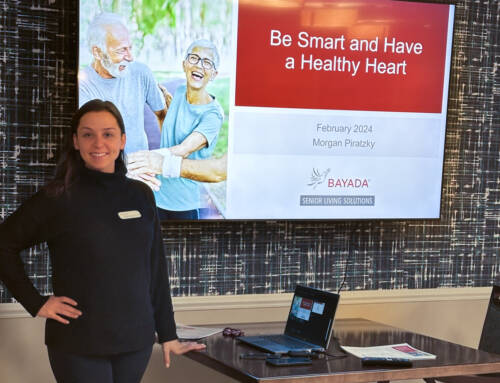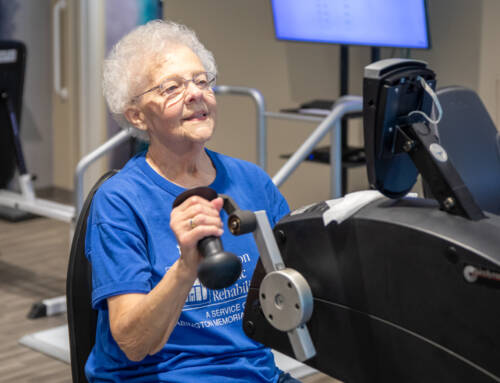Balance and fall prevention are key for older adults to avoid injury and remain confident and able to enjoy life to its fullest.
Three important elements play a part in maintaining balance, according to Jeanine Hendrie, wellness manager at Masonic Village at Lafayette Hill, who recently covered the topic with residents during a presentation.
- Visual component – similar to how a figure skater needs to find a focal point to maintain balance.
- Sensory system – feeling and being aware of different surface changes, from plush carpet to wood floors.
- Inner ear – or the “vestibular” system – letting us know when our head is moving side to side and up and down.
These three systems work together to send the brain responses to maintain equilibrium and balance. Factors such as medication and musculoskeletal issues from weakness, muscle imbalance and pain can result in a loss of balance.
“As we age, some of these components begin to diminish,” Jeanine said. “Our fear of falling may increase. It might make someone turn down, for example, an offer from your children to join your grandchildren at the local pumpkin patch.”
Jeanine has specialized in balance and mobility for the past 18 years, teaching at Doylestown Hospital’s Health and Wellness Center, Wesley Enhanced Living in Doylestown and BAYADA Home Health Care. In 2006, she earned her certification in balance and mobility through Fullerton College’s Center for Successful Aging.
“I am passionate about balance because it’s an essential part of our lives, from the time we walk to our older years,” she said. “Keeping track of participants’ maintenance and progression can help avoid a decline in balance and reduce the risk of falls.”
Jeanine shared some key exercises and progressions to help residents maintain and increase their balance as they age, including “sit to stand” – the continuous motion of getting up and down from a chair, practicing with or without using your hands.
“This is one of the most important exercises you can practice, at least 10 to 15 times a day,” she said. “This aids in your ability to get out of bed or off the couch.”
Residents also learned about the “balance efficacy scale,” answering a series of questions about how confident they were in carrying out daily activities.
An average (competency) score is given based on his or her individual answers. The lower the score, the more fearful or unable you are to perform certain activities. The higher the score, the more confident you are in your own balance.
“It [the test] gives you a sense of what makes you afraid of falling and what you can and can’t do,” Jeanine said.
Jeanine offers a balance class for residents every Tuesday, at 12:45 p.m., in the Multi Purpose Room. Every six months, she conducts a senior fitness test for residents to monitor their progress based on age and gender.
The Wellness Center also has an HUR Balance Trainer, offering different games to test agility and increase balance.
“Based on computer games, residents can work on reaction time and shifting their center of gravity to improve balance,” Jeanine said.
Jeanine’s overall goal through education and testing is to help residents keep enjoying a high quality of life by improving balance and confidence and reducing their fear of falling to maintain an active lifestyle.




